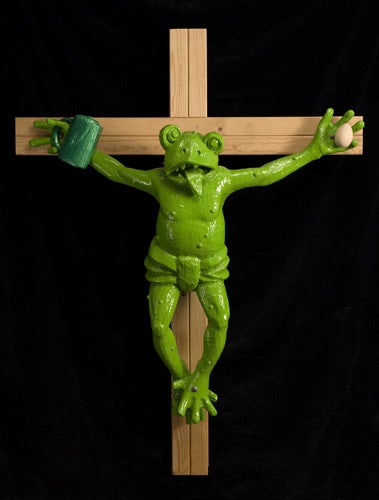Pope angry over crucified green frog sculpture

A sculpture of a crucified frog threatened with eviction from Bolzano’s new modern art museum after being condemned by the pope, the minister of culture and local right-wing politicians is staying where it is.
Today the museum's governing committee decided "by a clear majority" to keep it on display.
The work by the late German artist Martin Kippenberger shows a lurid green frog, warty and bug-eyed, nailed to a cross with its tongue hanging out - but holding a foaming tankard of beer in one hand and an egg in the other.
Exhibited in the inaugural exhibition of the new Museion in the centre of this German-speaking city in Italy's far north, it was said by the museum curators to be a self-portrait of the artist "in a state of profound crisis." But attacks on the work, which began locally, culminated in a letter to a local critic from the pope and a condemnation by the minister of culture.
The warning shots were heard back in May, after the exhibition's opening. The president of the Bolzano region, Luis Durnwalder, said it was "an offence." While noting that it was not the job of politicians to sit in judgement on art, he said the work "could be felt as a provocation on the part of the population of Alto Adige, 99 per cent of whom are Catholic."
Then the broadsides began. Franz Pahl, president of the regional council, said the work was "not art but a blasphemy and a disgusting piece of trash that offends many people." A separatist group, the Union for South Tyrol, got up a petition to have it removed, and said it had collected 10,000 signatures. Mr Pahl, who made the frog's removal his personal crusade, went on hunger strike, and after eight days was taken to hospital. Pope Benedict spent his summer holiday in the region, and this week Mr Pahl said he had written to him to say the piece "injured the feelings of many people who see in the cross the symbol of the love of God and of our salvation which deserves recognition and religious devotion."
Yesterday Sandro Bondi, minister of culture in the central government, joined the chorus of condemnation. The work, he said, "not only wounds the religious feelings of many who see in the cross the symbol of the love of God, but also offends the good sense and feelings of those who do not identify with the symbol." Mr Bondi recently said on the record that he did not understand modern art.
For Mr Kippenberger, whose work has been shown at the Tate Modern and the Saatchi Gallery and who died in 1997 aged 44, the grotesque amphibian was an alter ego. He completed a series of works depicting it in different poses.
The museum moved the four-foot high work from the entrance, but refused to get rid of it. And today it shrugged off the pressure. Alois Lageder, the museum's director, told The Independent, "The controversy has been exploited by politicians including Mr Pahl for electoral reasons. It's true the pressure was heavy but we are an autonomous museum and we have taken our decision. The work aroused a lot of argument among visitors, many liked it and many disliked it – but the public row was merely political. And it has gone on long enough."
Join our commenting forum
Join thought-provoking conversations, follow other Independent readers and see their replies
Comments
Bookmark popover
Removed from bookmarks